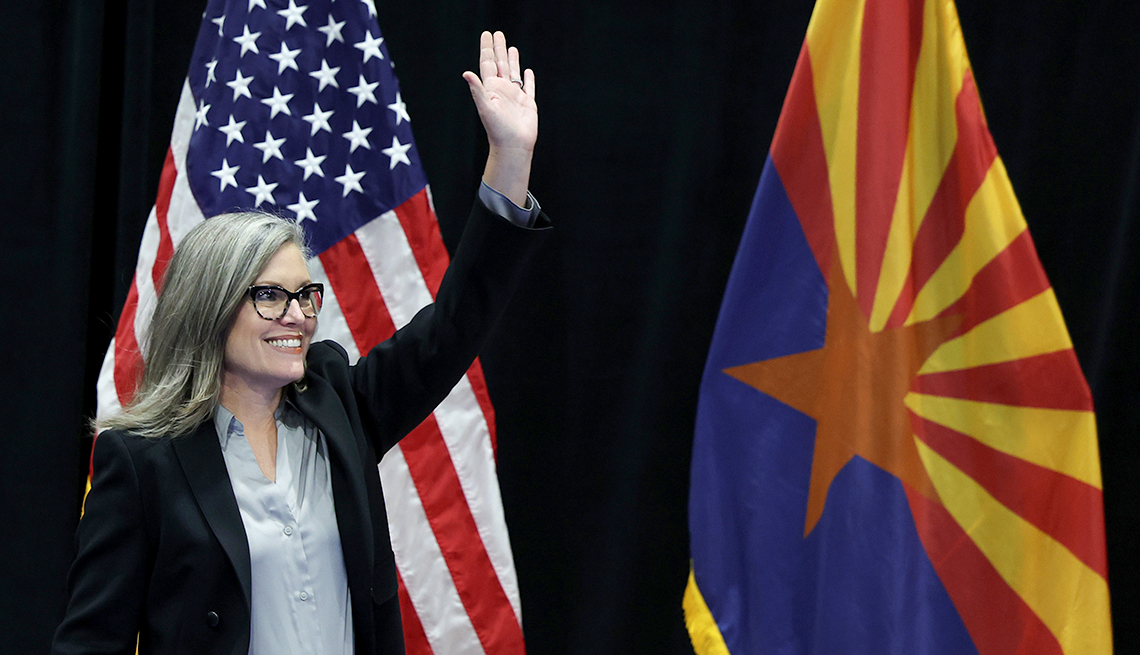AARP Hearing Center

Making political predictions is often a fool’s game, so it’s too early to know how Gov. Katie Hobbs will fare in her first term.
But one thing seems certain: There will be far more Arizonans — and more 50-plus Arizonans — at the end of her term than there are now. With Arizona’s population growing at well above the national rate, the state predicts there will be 2.9 million residents over 50 by 2026.
Serving them will be a big part of Hobbs’ job, she tells the AARP Bulletin. As current residents age and out-of-state retirees move in, Arizona must plan for their housing and transportation, health care and public spaces, she says. Hobbs discussed her strategy for doing so in an April interview with the Bulletin.
“It’s critical that we’re taking care of them, and their caregivers,” she says.
Hobbs inherited state plans on aging and Alzheimer’s disease. She says her administration will continue seeking input on both, hoping to make Arizona “an age-friendly and dementia-friendly state.”
Among her priorities:
Alzheimer's disease In 2020, 150,000 Arizonans 65 and older had Alzheimer’s. That’s expected to grow to 200,000 by 2025, according to the Alzheimer’s Association — a 33 percent jump, the biggest in the country.
Hobbs is working to create positions to coordinate Alzheimer’s and related dementia work. The coordinators will work with stakeholders to create, implement and evaluate policies necessary to support individuals living with such diseases. Hobbs also sought to boost Alzheimer’s research. In the fiscal 2024 budget, funding was increased by $500,000 on an ongoing basis, to $4.1 million.
Affordable housing Hobbs successfully proposed adding $150 million to the state’s Housing Trust Fund for incentive payments to developers building affordable housing, rent and utility assistance, eviction prevention and other resources. A low-income housing tax credit, set to expire in 2025, should also become permanent, she says.
“The folks providing services to the unhoused population have consistently let us know that they’re seeing a growing share of seniors experiencing homelessness,” she says.
Hobbs says Senior Haven — a planned homeless shelter in Phoenix for up to 170 people 55 and older — could be replicated elsewhere. Led by Central Arizona Shelter Services, the center is set to open later this year.
Long-term care Before Hobbs took office, the state auditor general criticized government oversight of long-term care, due to skipped inspections, ignored complaints and other problems. “We have really had a reactive, rather than proactive, response,” she says of long-term care management, adding that the state should be more preventive.
She’d like to commit more resources to long-term care and address staffing shortages in government programs. Hobbs would also support legislation for a paid caregiver wage increase.
Beyond that, filing reports on elder abuse — whether physical or financial — should be easier, Hobbs says. “Right now, there are just so many different places that people can report. ... We need to streamline that,” she says.
Hobbs will take guidance from the Governor’s Advisory Council on Aging, which includes an AARP representative: Brenda Holt, director of community outreach in Maricopa County.
“The well-being of our older population and their caregivers has to be a top priority in Arizona, and we stand by Gov. Hobbs in achieving her 50-plus goals,” adds Brendon Blake, AARP Arizona’s advocacy director.
Find the Arizona State Plan on Aging at des.az.gov/services/older-adults.
Sarah Hollander is a writer living in Cleveland, Ohio.
More on Dementia, Affordable Housing and Long-term Care
- Latinos and Alzheimer’s Disease: The Growing Crisis
- Addressing Housing Challenges Across the U.S.
- AARP Resources on Long-Term Care































































